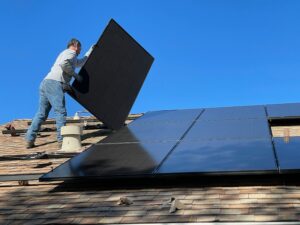Retrofitting homes has been an important part of climate action for some time now. Older buildings use more energy to do the same job, and that means that more fossil fuels need to be burned to heat an older home to a livable temperature.
In this post, we’ll be going through some of the grants available to Irish people who want to reduce their carbon emissions and save money in the long term. These grants have become far more available and easy to use in the last few years, to the extent that many Irish people will likely be surprised by how much is actually on offer!
Why Do We Need to Retrofit Homes?
These days, it seems like energy prices are all anyone can talk about, and with good reason. At the beginning of October 2022, Electric Ireland raised the average price of an electricity bill by 26.7%. This comes after wholesale electricity prices had already increased by 45.1% between July and August of 2022, making them 194.9% higher than they were at the same time the previous year.
As a result of these price increases, we are all feeling the need to reduce our energy usage. It is either that or break the bank. Many people who can afford the upfront cost are now retrofitting their homes to reduce electricity consumption, and it is not just their electricity bills that are feeling the benefits.

We have known for a long time that climate change poses a serious risk to humanity. Residential energy use makes up about a quarter of all the Greenhouse Gas (GHG) emissions from energy use in Ireland. Retrofitting homes, then, is a very good way to reduce our total energy consumption. As it stands, we are burning fossil fuels for heat, then allowing a good deal of that energy to fly straight out the window. I’ve heard of global warming but this is ridiculous!
What is BER?
Before we get into the weeds about what is actually available through government schemes, it is important to understand BER ratings. This is essentially a grading system for the energy efficiency of homes, with A being the most efficient and G the least efficient.
BER ratings are based on how much energy is required to heat, ventilate and light the home. In order to get a BER, you do not need to know how much energy all your appliances are using, since this is not relevant. It is just the home itself rather than how the home is used.
You will need a BER if you want to rent, sell or buy a home. They are also required before and after receiving a government retrofitting grant. Don’t worry though, the cost of the BER assessment is often included in the grant!
Better Energy Warmer Homes Scheme
The first scheme we will discuss here is the Better Energy Warmer Homes scheme. This grant involves free energy upgrades and is aimed at lower income households. It covers attic insulation, wall insulation (including cavity wall, internal wall and external wall insulation), draught-proofing, lagging jackets, energy efficient lighting and energy advice.
In order to qualify for this scheme, you must be receiving a social welfare payment like fuel allowance or carer’s allowance. Further details of who qualifies can be found on the citizen’s information website. Ok, now that we know what this scheme covers and who qualifies, we should talk about why this one is so important.
As mentioned above, fuel prices have absolutely skyrocketed since the invasion of Ukraine, and this is putting serious pressure on low-income households. By reducing heat loss through insulation and draught-proofing, these households can now get much more bang for their buck when it comes to paying for the heating.
Another huge consideration is climate justice. This is the idea that the burden and benefits of climate action should be equitably distributed, and that we should do everything we can to ensure that more vulnerable groups do not take on a disproportionate share of the impacts.
In the context of the Better Energy Warmer Homes Scheme, this means that people who cannot afford higher fuel prices should receive assistance from the government to improve the energy efficiency of their homes rather than simply being left behind.
Greater budget allocation for this scheme made it possible for about 320 home upgrades to be provided for free every month in 2022. This is a big improvement from the 177 homes that were upgraded per month in 2021, but still well behind target.
Better Energy Homes and National Home Energy Upgrade Schemes
I have lumped these two schemes into one heading, as they are very similar. In essence, the main difference is that in the Better Energy Homes scheme you manage the works yourself and hire a contractor to do the work, whereas in the National Home Energy Upgrade the works are managed for you by an SEAI approved contractor. The amount you get in grants for both of these schemes depends on the type of home you are living in, as well as the types of upgrades you are getting.
The National Home Energy Upgrade scheme, which is also known as the ‘One Stop Shop’ scheme, exists to bring houses up to a BER rating of B2 or higher. The reason it is also called the One Stop Shop scheme is that in order to get this one you need to go to an SEAI-approved private company, who will handle the whole process for you!
Not only will the private company do the actual work, they will also be the ones to apply for and accept the grant, and will arrange for BER assessments to be carried out before and after the work. In other words, you go to one of these companies and they do it all for you.
The list of works you can have done under this scheme is too large to repeat here, but suffice it to say that you have many options, from solar PV to heat pumps and new windows.
The maximum possible grant you can get for increasing your efficiency to B2 BER rating is about €25,000 – equivalent to 45-51% of the total cost of bringing a BER E2-rated house up to a B2. That means a big upfront payment will still be required from the individual seeking the grant. Going from E2 to B2, however, will provide huge savings over time. Specifically, it would reduce energy bills by about two thirds!
It is also important to remember that until very recently the grant available for retrofitting a building to get it to B2 only covered about 30-35% of the cost, so doing it now is a lot cheaper than it would have been even last year!
Grants for Solar PV
You may need to apply for a grant to get solar panels separately to the other schemes. It is recommended that you upgrade your insulation first, as this is the easiest way to reduce energy costs. It makes sense to stop wasting energy before you switch to cleaner energy.

There is a small chance you will need to apply for planning permission for a solar panel array, but this is only the case if your home is a protected structure or part of an architectural conservation area. You will also need to get a BER assessment after the work is complete.
The amount you receive from these grants depends on the amount of electricity the panels will generate at their peak. You can apply for this grant online or through the post.
Where Does This Money Come From?
Most of the money invested in these schemes comes directly from the carbon tax! Specifically, €202m out of a total €267m. This is an important use of the carbon tax money, and makes the tax more acceptable to the average person.
If the carbon tax money was simply being lumped in with the rest of the tax, the average person might assume that it was being used to raise TD salaries or provide grants to landlords. By earmarking the money for environment-friendly schemes, we can see that the tax is being used as it was intended.
Public acceptance of carbon tax is important, since it has been shown to improve price parity between renewables and fossil fuels, making it more viable to invest in green technologies. When done incorrectly, carbon tax can put undue burden on lower income households. When done correctly, however, it can actually help these households by alleviating the pressure of high energy prices resulting from the invasion of Ukraine.
Problems With Government Retrofitting Schemes
So far, it seems that the retrofitting schemes are falling well behind their targets. We have a goal of deep retrofitting 500,000 homes by 2030, representing 30% of the total housing stock in the country. So far, we have only managed about 28,800 homes. While this is pretty good, we still have a very long way to go. Some have argued that we should now be prioritising the ‘shallow fixes’ like wall cavity insulation before we do anything else.
Government officials have expressed the view that one reason for the disparity between the target and the actual number of retrofits is low uptake. This is patently false, since the waiting list for the Better Energy Warmer Homes scheme is currently about 27 months. People are applying for the grants, but the government is unable to supply what they have promised.
One of the problems faced by the schemes is the increased price of building materials that has resulted from the COVID-19 pandemic. There is also of course the general challenge of inflation being faced by all sectors of the economy right now.
Another major issue is the number of households who are eligible. Private renters, for example, who number in their hundreds of thousands, cannot avail of the grants. In addition, people who live in extremely inefficient houses but do not receive the appropriate social welfare payments simply cannot afford the upfront costs of retrofitting.
Conclusion
You can get a surprising amount of money for upgrading the energy efficiency of your home. While it will still cost you quite a bit upfront, you will make that money back in a few years through the savings in your electricity bill. With energy prices still rising, and carbon tax set to increase year on year, the amount of time it will take to make the money back may turn out to be shorter than you think.
If you can afford to retrofit your home, it is a very good use of your money. With up to 80% of the costs covered by grants, you are getting something that is worth a lot more money than the amount you actually spend. Not only will it help you financially in the long run, you can also rest easy knowing that when you turn on the heating, you are having a much lower impact on the environment than you would otherwise.
To say that the climate crisis must be urgently solved is the understatement of the century. Thanks to decades of inaction, we now have to move incredibly quickly if we are to avoid a catastrophe on a scale humanity has never before experienced. Better get retrofitting!
Sources
-Grants for Solar PV
– about a quarter of all the Greenhouse Gas (GHG) emissions
–Better Energy Homes scheme
–National Home Energy Upgrade Scheme
–https://www.newstalk.com/news/how-the-new-national-retrofitting-scheme-will-work-1309399
